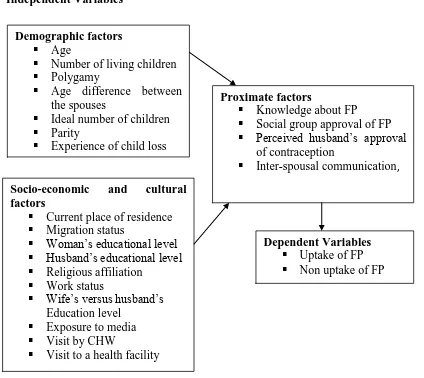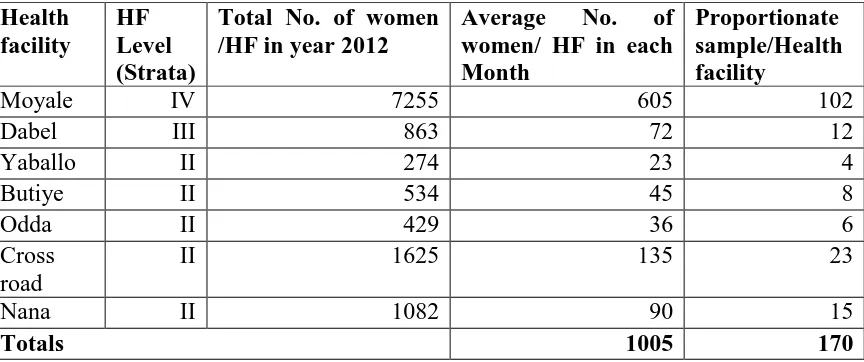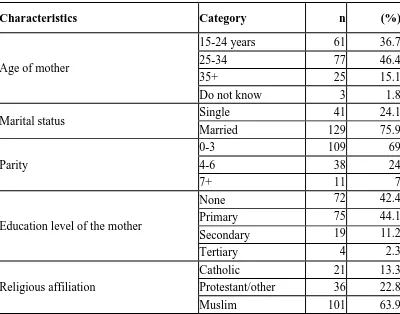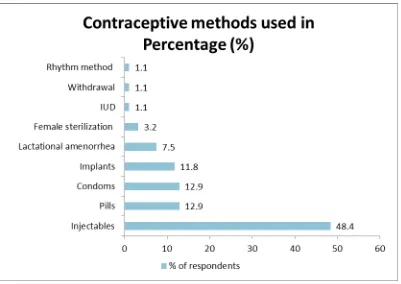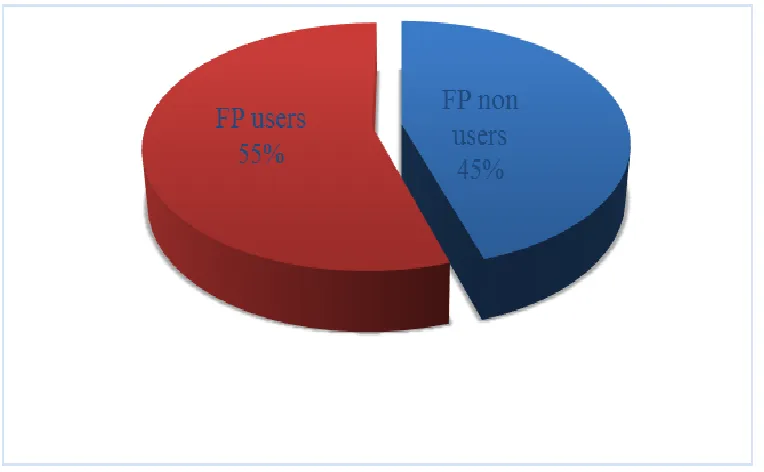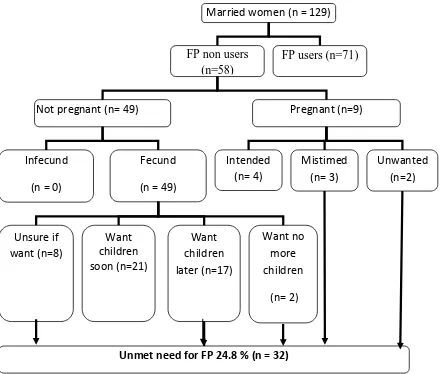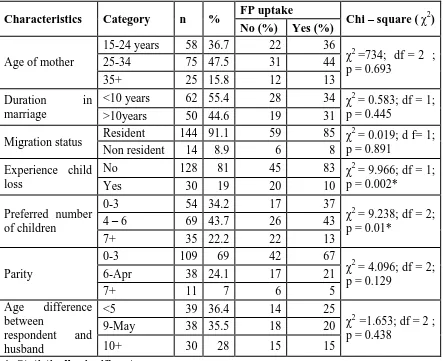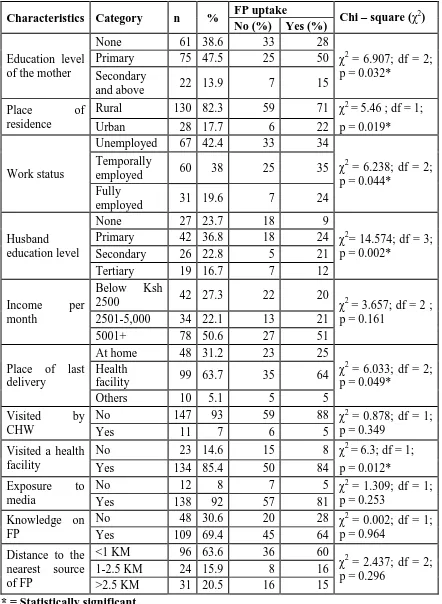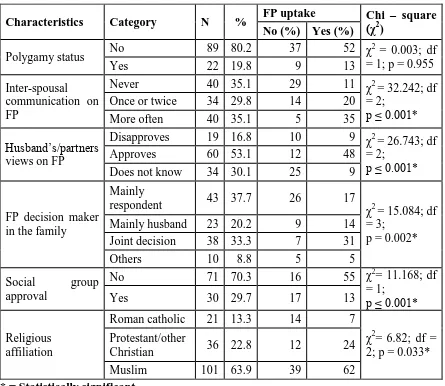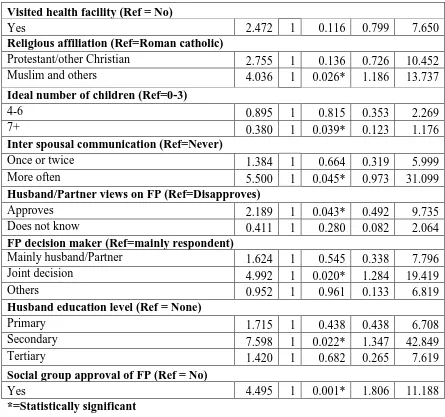FRANCIS KYALO MUEMA (B.Sc.) P57/23671/2011
A RESEARCH THESIS SUBMITTED IN PARTIAL FULFILMENT FOR THE AWARD OF THE DEGREE OF MASTER OF PUBLIC HEALTH
(MONITORING AND EVALUATION) IN THE SCHOOL OF PUBLIC HEALTH OF KENYATTA UNIVERSITY.
DECLARATION
This thesis is my original work and has not been presented for a degree in any other university.
Signature:……… Date:……… Francis Kyalo Muema
Department of Community Health
Supervisors:
This thesis has been submitted for review with our approval as university Supervisors
1. Signature:………... Date……… Dr. George O. Otieno
Department of Health Management and Informatics
2. Signature:……… Date………
Dr. Justus O. S. Osano
DEDICATION
ACKNOWLEDGEMENTS
I praise the almighty God for his profound loving, kindness and grace which accompanied me during the entire research period. I thank all my lecturers at Kenyatta University, School of Public Health, from whom I have learned a lot throughout my training in the field of Public Health. I am particularly grateful to my supervisors Dr. George O. Otieno and Dr. Justus Osero for their unwavering, unconditional, constructive support and guidance throughout the entire research period. Your questions and critical comments immensely enriched the content of my research proposal and this thesis. May God bless you abundantly for the passion you have in your work.
TABLE OF CONTENTS
DECLARATION... ii
DEDICATION... iii
ACKNOWLEDGEMENTS ... iv
TABLE OF CONTENTS ... v
LIST OF TABLES ... ix
LIST OF FIGURES ... x
LIST OF ABBREVIATIONS AND ACRONYMS ... xi
DEFINITION OF TERMS... xii
LIST OF ABBREVIATIONS AND ACRONYMS ... xiii
ABSTRACT ... xiv
CHAPTER ONE: INTRODUCTION ... 1
1.1 Background to the study ... 1
1.2 Statement of the problem ... 2
1.3 Justification of the Study ... 3
1.4 Research objectives ... 3
1.4.1 Broad Objective ... 3
1.4.2 Specific Objectives ... 3
1.5 Research questions ... 4
1.6 Hypothesis ... 4
1.7 Significance of the study ... 5
1.8 Limitations and delimitations ... 5
1.9 Conceptual framework ... 5
CHAPTER TWO: LITERATURE REVIEW ... 7
2.2 Overview of FP ... 7
2.2.1 Global overview of FP ... 7
2.2.3 FP services provision in Kenya ... 8
2.3 Evolution of the Kenyan population policy ... 8
2.4 Current FP policies and strategies in Kenya ... 9
2.5 Factors influencing uptake of FP services ... 10
2.5.1 Socio-demographic and economic factors influencing FP services uptake ... 11
2.5.2 Socio-cultural factors influencing FP services uptake ... 12
CHAPTER THREE: MATERIALS AND METHODS ... 16
3.1 Introduction ... 16
3.2 Study design ... 16
3.3 Study variables ... 16
3.3.1 Dependent variables ... 16
3.3.2 Independent variables ... 16
3.4 Study area ... 17
3.4.1 Location of Moyale Sub-county ... 17
3.4.2 Justification of study area ... 17
3.5 Study population ... 18
3.5.1 Inclusion criteria ... 18
3.5.2 Exclusion criteria ... 18
3.6 Sampling techniques and sample size determination ... 19
3.6.1 Sample size determination ... 19
3.6.2 Sampling technique ... 19
3.7 Research instruments ... 20
3.8 Pre-testing ... 20
3.8.2 Reliability ... 21
3.9 Data collection techniques ... 22
3.10 Logistical and Ethical considerations ... 22
3.11 Data Management and Analysis ... 23
CHAPTER FOUR: RESULTS ... 24
4.1 Introduction ... 24
4.1.1 Socio – demographic characteristics of the respondents ... 24
4.2 Contraceptive methods used by the respondents ... 25
4.2.1 Prevalence of FP uptake among the respondents ... 26
4.3 Unmet need and total demand for FP ... 27
4.4 Determinants of FP uptake ... 30
4.4.1 Socio - demographic determinants of FP uptake ... 30
4.4.2 Socio-economic determinants of FP uptake ... 33
4.4.3 Socio – cultural determinants of FP uptake ... 37
4.5 Contribution of independent predictors on FP uptake ... 40
CHAPTER FIVE: DISCUSSION, CONCLUSION AND RECOMMENDATIONS 44 5.1 Introduction ... 44
5.1.1 Contraceptive methods used by the respondents ... 44
5.1.2 Level of unmet need and total demand for FP services among the respondents ... 45
5.1.3 Contributions of socio-demographic, economic and cultural factors on FP services uptake among the respondents………..……45
5.2 Conclusion ... 48
5.3 Recommendations from the study ... 49
5.4 Suggestions for further research ... 49
REFERENCES ... 50
Appendix I: Informed Consent Form for respondents ... 56
Appendix II: Interview schedule ... 61
Appendix III: FGD guide ... 67
Appendix IV: Key informant interview guide ... 69
Appendix V: Map showing location of Moyale Sub-county in Kenya ... 70
Appendix VI: Graduate school research authorization letter ... 71
Appendix VII: Kenyatta university ethics review committee approval letter ... 72
Appendix VIII: NACOSTI research authorization letter ... 74
LIST OF TABLES
Table 3.1: Distribution of respondents per health facility...……...……….……….…….20
Table 4.1: Socio - demographic characteristics of the respondents………..25
Table 4.2: Socio - demographic determinants of FP uptake………..32
Table 4.3: Socio-economic determinants of FP uptake……….36
Table 4.4: Socio - cultural determinants of FP uptake……….…..39
Table 4.5a: Independent predictors of FP uptake………..43
LIST OF FIGURES
Figure 1.1: Conceptual framework for predictors of FP services uptake ... 6
Figure 4.1: Contraceptive methods used by the respondents……….26
Figure 4.2: Prevalence of FP uptake………..27
LIST OF ABBREVIATIONS AND ACRONYMS AIDS Acquired Immune Deficiency Syndrome
ANC Ante Natal Care
DHMT District Health Management Team HF Health Facility
HIV Human Immunodeficiency Virus HTC HIV Testing and Counselling
KDHS Kenya Demographic and Health Survey KNBS Kenya National Bureau of Statistics KSPA Kenya Service Provision Assessment MCH/FP Maternal and Child Health/Family planning MDGs Millennium Development Goals
MNCH Maternal, Newborn and Child Health MOH Ministry of Health
MOMS Ministry of Medical Services
MOPHS Ministry of Public Health and Sanitation MTCT Mother to Child Transmission of HIV
NACOSTI National Commission for Science Technology & Innovation NAL Northern Arid Lands
NCPD National Council for Population and Development NHSSP National Health Sector Strategic Plan
DEFINITION OF TERMS
Family planning - Refers to the voluntary practice of regulating the number and spacing of children through contraception or other methods of birth control
Infecund women -Women who were first married five or more years ago, never used contraception, and have not had a birth in the past five years
FP uptake - Current use of any contraceptive method
Migration status - Refers to whether the respondent moved from one area of residence to another in the last six months
Preferred number of children - The number of children one would wish to have during his/her life time
Unmet need for FP- Percentage of women of reproductive age, either married or in a union, who are fecund and sexually active but are not using any method of contraception, and report not wanting any more children or wanting to delay the next child.
LIST OF ABBREVIATIONS AND ACRONYMS AIDS Acquired Immune Deficiency Syndrome
ANC Ante Natal Care
DHMT District Health Management Team HF Health Facility
HIV Human Immunodeficiency Virus HTC HIV Testing and Counselling
KDHS Kenya Demographic and Health Survey KNBS Kenya National Bureau of Statistics KSPA Kenya Service Provision Assessment MCH/FP Maternal and Child Health/Family planning MDGs Millennium Development Goals
MNCH Maternal, Newborn and Child Health MOH Ministry of Health
MOMS Ministry of Medical Services
MOPHS Ministry of Public Health and Sanitation MTCT Mother to Child Transmission of HIV
NACOSTI National Commission for Science Technology & Innovation NAL Northern Arid Lands
NCPD National Council for Population and Development NHSSP National Health Sector Strategic Plan
RH/FP Reproductive Health/ Family Planning
ABSTRACT
CHAPTER ONE: INTRODUCTION
1.1 Background to the study
Globally, 146 million married women of reproductive age had an unmet need for family planning in 2010 and it is estimated that by end of 2015 this number will increase to 153 million. The vast majority of these women are in the developing nations especially in African continent (Alkema, 2013).
Currently, in Sub - Saharan Africa (SSA), at least 25% of women aged 15-49 have unmet need for FP and about 14 million unintended pregnancies occur each year. Over the next 40 years, Africa’s population is expected to double from 1 to 2 billion thus accounting for 22% of world population, up from 15% in 2010. In Kenya, the unmet need for family planning is at 25% while 17% of births are reported as unwanted or unplanned. Use of contraceptives is also generally lower in rural areas in comparison to urban areas with family planning use reported at 43% and 53% respectively. According to KDHS (2009), 88 % of women aged 15-49 years were not using any contraception method in Moyale sub -county while only 7 % of the married women or in a union reported current use of contraception.
Family planning (FP) is not only a key intervention for improving health but also, a key strategy for the achievement of national and international development goals including Kenya vision 2030 and Millennium Development Goals (MDGs) (MoH, 2010). FP is a human right and it is identified as a priority component in the National Reproductive Health Policy (MoH, 2007). All individuals have the right to access FP, including all FP-pertinent data regarding benefits and scientific progress made in the area of contraception.
In Kenya and other African countries, one of the main factors contributing to the challenge of achieving MDGs is the continued rapid growth of the population. The number of people in need of health, education, economic, and other services is large and increasing, which, in turn, means that the amount of resources, personnel, and infrastructure required to meet the MDGs is also increasing. In light of this fact, development efforts in support of the MDGs recognize the importance and benefits of slowing population growth. Enhancing FP use has the potential to helping Kenya significantly reduce the costs of meeting the five selected MDGs, including: achieving universal primary education, reducing child mortality, improving maternal health, ensuring environmental sustainability and combating HIV/AIDS, malaria, and other diseases (Republic of Kenya, 2007).
1.2 Statement of the problem
national target. This is mirrored in the low CPR (Contraceptive Prevalence Rate) of 12% and high fertility rate of 4.9 (DHIS, 2012 & KDHS, 2009).This worrying situation is attributed to various socio-demographic, economic and cultural factors as demonstrated by KDHS 2009. As such, this study examined the significance of these factors as predictors of FP services uptake in the Sub-county. To attain this, a cross-sectional descriptive study was conducted among women of reproductive age visiting health facilities in the Sub-county.
1.3 Justification of the Study
The findings from this study will be valuable in informing the government, non-governmental and private organizations, faith based organizations, individual women, programmers and policy makers on strategies to promote FP services uptake, interventions and FP delivery protocols that are responsive to the unique context and needs for Moyale Sub-county residents.
1.4 Research objectives
1.4.1 Broad Objective
To examine predictors of FP services uptake among women of reproductive age visiting health facilities in Moyale Sub-county
1.4.2 Specific Objectives
The specific objectives of this study were:
2. To determine the level of unmet need for FP services among the women of reproductive age visiting health facilities in Moyale Sub-county
3. To determine the total demand for FP services among the women of reproductive age visiting health facilities in Moyale Sub-county
4. To find out the contributions of socio-demographic, economic and cultural factors on FP services uptake among the women of reproductive age visiting health facilities in Moyale Sub-county.
1.5 Research questions
1. What are the contraceptive methods used by women of reproductive age visiting health facilities in Moyale Sub-county?
2. What is the level of unmet need for FP services among women of reproductive age visiting health facilities in Moyale Sub-county?
3. What is the total demand for FP services among women of reproductive age visiting health facilities in Moyale Sub-county?
4. What are the contributions of socio demographic, economic and cultural factors on FP services uptake among women of reproductive age visiting health facilities in Moyale Sub-county?
1.6 Hypothesis
1.7 Significance of the study
Currently there is limited information on the prevalence and determinants of FP services uptake in resource limited and Islam dominated regions of northern Kenya. This study will help fill in this gaps in knowledge by gauging the current level of FP services uptake and its predictors.
1.8 Limitations and delimitations
The study used a sample drawn from women of reproductive age visiting HFs in the Sub-county and who were seeking services such as immunization, FP and growth monitoring for their children. The study was limited to determination of contraceptive methods used by the women, total demand for FP services, level of unmet need for FP and contribution of factors influencing FP services uptake only. It did not extend to study of health system factors.
1.9 Conceptual framework
Figure 1.1 lays the conceptual framework for this study. Two groups of variables are used to examine factors influencing uptake of FP services. The independent variables, which influence the uptake of FP services of the study population, are subdivided into three sets. The first two are the underlying factors which include important demographic and socioeconomic variables. The third group of independent variables is the proximate determinants which are women’s knowledge, attitudes, couple communication and perceptions about FP.
be the underlying determinants of FP services uptake. That is, the effect of the underlying factors is expected to reach the ultimate dependent variable through the assumed proximate variables. Independent Variables
Figure 1.1: Conceptual framework for predictors of FP services uptake Source: Adopted and modified from Korra, (2009).
Socio-economic and cultural factors
Current place of residence
Migration status
Woman’s educational level
Husband’s educational level
Religious affiliation
Work status
Wife’s versus husband’s Education level
Exposure to media
Visit by CHW
Visit to a health facility Demographic factors
Age
Number of living children
Polygamy
Age difference between the spouses
Ideal number of children
Parity
Experience of child loss
Proximate factors
Knowledge about FP
Social group approval of FP
Perceived husband’s approval of contraception
Inter-spousal communication,
Dependent Variables
Uptake of FP
CHAPTER TWO: LITERATURE REVIEW
2.1 Introduction
This chapter primarily discusses the existing literature on FP while highlighting the knowledge gaps on FP which needs to be addressed. It also gives an overview of current global, regional, national and local trends in FP as well as explaining evolution of FP policy in Kenya.
2.2 Overview of FP
2.2.1 Global overview of FP
It is estimated that more than 100 million women globally especially in less developed countries or about 17% of all married women, would prefer to avoid pregnancy but are not using any form of family planning (Ross & Winfrey, 2009). Also, within the less developed regions of the world, about one-fourth of all pregnancies are unintended (Haub & Herstad, 2008), while an estimated 18 million unsafe abortions take place each year (Murray & Lopez, 2010), thereby contributing to the high maternal mortality and injuries.
Family planning is one of the fundamental pillars of safe motherhood and a reproductive health right. The practice of family planning is influenced by several socio economic, social cultural and demographic factors, hence its variation between regions of the world, countries and within countries. In Africa, it is pertinent to reposition family planning to accelerate the reduction of maternal and neonatal mortality in less developed countries.
2.2.2 FP overview in Kenya
observed from the mid-1970s to the late 1990s. Current fertility rates differ for urban and rural areas and across the provinces in Kenya. The TFR in rural areas (5.2 births) is significantly higher than in urban areas (2.9 births). Kenya has a low CPR of 45% with 25% unmet need for family planning (KDHS, 2009).
2.2.3 FP services provision in Kenya
According to 2010 KSPA, modern family planning services are available in 85% of all health care facilities in Kenya. Almost all (96%) government facilities offer family planning compared to 89% of NGO, 84% of private and only 44% of FBO facilities. Family planning services are widely available in all types of facilities, ranging from 80% of clinics to 89% of dispensaries. The 2010 KSPA indicated that most HFs (88%) providing temporary methods provide these services five or more days per week.
2.3 Evolution of the Kenyan population policy
In the early 1980s, the then government encouraged reduction in the population and budgetary allocations were made for FP services. The Sessional Paper No. 4 of 1984 on Population Policy Guidelines led to the establishment of the National Council for Population and Development (NCPD). The NCPD was to act as an umbrella organization in supporting, coordinating and strengthening the IEC programs and activities of the participating agencies. During this period, FP services were delivered through government health institutions, private hospitals, Non-Governmental Organizations and some church related health institutions. The 1997 draft National Population Policy for Sustainable Development called for an increase in contraceptive prevalence rate from 33 per cent (in 1993) to 68 per cent.
During the 1980s and early 1990s, the Kenyan government demonstrated considerable commitment to FP through the development of national policies and guidelines, involvement of high-level politicians, the establishment of the National Council for Population and Development (NCPD) in the Office of the Vice President, and support for increased distribution of contraceptives through governmental and non-governmental health facilities, and extensive information, education and communication (IEC) campaigns (Ajayi & Kekovole, 1999). In 1996 the NCPD published its National Population Advocacy and IEC Strategy for Sustainable Development, 1996 – 2010, the aim of which was to promote the use of modern contraceptive methods among less educated women (RoK, 1994).
2.4 Current FP policies and strategies in Kenya
Sector Strategic Plan (NHSSP II) for the period 2005-2010 recognizes RH (including FP) as an essential priority in the Kenya Essential Package for Health (KEPH). In addition, the Plan has a Community Strategy to strengthen the interface between all levels of the health care system. This strategy has provided a mechanism through which RH services, including FP, can be extended down to the grassroots level by community health workers (CHWs).The National Reproductive Health Policy (NRHP) 2009-2015 lists FP among the priority RH components, and has identified priority actions that must be taken to attain national and international goals. Its objectives are to reduce the unmet need for FP, reduce unplanned births, and narrow the socio-economic disparities in the Contraceptive Prevalence Rate.
2.5 Factors influencing uptake of FP services
The influence of physical access on the utilization of FP services is well founded, with many studies demonstrating the greater use of services among women who live in relative proximity to a service (Tsui et al., 2009). Research into the barriers faced in accessing reproductive health services, however, now recognizes that problems of access extend beyond physical access to services, and include issues of economic, cultural and psychosocial access (Bertrand et al., 2008).
2.5.1 Socio-demographic and economic factors influencing FP services uptake
Demographic factors that have been shown to increase the likelihood of using reproductive health services are; low parity and younger maternal age (Magadi et al., 2000). Socioeconomic factors, however, have been shown to be of greater importance in determining health service utilization than demographic factors (Obermeyer & Potter, 1991). Whilst demographic factors may shape the desire to use services (for example younger women may have more modern attitudes towards health care use) the socioeconomic status of an individual and the household in which they live determines the economic ability to utilize health services and economic dimension of access).
In terms of socioeconomic factors, the most consistently found determinant of reproductive health service utilization is a woman’s level of educational attainment (Magadi et al., 2000). It is thought that increased educational attainment operates through a multitude of mechanisms in order to influence service use, including increasing female decision-making power, increasing awareness of health services, changing marriage patterns and creating shifts in household dynamics (Obermeyer & Potter, 1991). Socioeconomic indicators such as urban residence, household living conditions (Magadi et al., 2000), household income, women’s employment in skilled work outside the home,
high levels of husband’ education and occupational status have also proven to be strong predictors of a woman’s likelihood of utilizing reproductive health services.
individual actions and psychosocial aspect of access (Rutenberg & Watkins, 2002). Although individual demographic and socioeconomic factors may shape an individual’ s desire and ability to use a service, the cultural environment in which an individual lives exerts a strong influence on the extent to which these factors actually lead to service utilization.
2.5.2 Socio-cultural factors influencing FP services uptake
Most people’s FP decisions reflect a range of outside influences. Social and cultural norms, gender roles, social networks, religion, and local beliefs influence peoples’ choices (Caldwell & Caldwell, 2002). To a large extent, these community norms determine individual childbearing preferences and sexual and reproductive behavior. Community and culture affect a person’s attitude towards FP, desired sex of children, preferences about family size, family pressures to have children and whether FP accords with customs and religious beliefs, (Dixon-Mueller, 1999).
or other adults to know that they are sexually active. Many fear ridicule, disapproval and hostile attitude from service providers and others (Jejebhoy, 2004). A person’s social environment usually has more influence on FP decisions than do the attributes of specific contraceptives. In Kenya, for example, when new clients were asked to give a single reason for their choice of a specific FP method, most cited the attitudes of their spouse or their peers, or their religion or value (Kim et al., 1998).
In many countries FP programs are part of national economic and social development efforts. Efforts to foster equity in decision-making and raise awareness about reproductive right of the family, community, and society also promote informed choice of FP (Jacobson, 2000). As women gain more autonomy, they are better able to claim their rights as individuals, including the right to act to protect their own reproductive health (Heise et al., 1999).
Everybody belongs to informal social networks that influence their behavior to some degree (Montgometry, 2000). Social networks include the extended family, friends, neighbors, political groups, church group, youth groups, and other formal and informal associations. During the course of the day, women often speak to other women about FP and experience with contraceptive use. For many women, informal communication is a primary source of FP information (Rotenberg & Watkins, 2002).
Nigeria and other West African Countries for example, some women said that, it was difficult for them to use FP because their relatives or friends were not using it. These women were reluctant to be the first in their social group to use FP (Stash, 2000). People choose contraceptive methods that are commonly used in their community because they know that it is socially acceptable to do so, and they tend to know more about these methods (Rogers & Kincaid, 2004). Many women use the same FP method that others in their social networks use (Godley, 2011).
A study in urban Nigeria in 1998 found that the more widely used a method was, the more attractive it became to others in the cities and villages (Entwisle et al., 1999). Entire communities may encourage one type of contraceptive based on the choices of early contraceptive users, rather than individual needs (Potter, 1999). Even when people are aware of the side effects or failures experienced by other users of a method, sometimes they still prefer it because it is familiar, (Entwisle et al ,1999).
While social networks exerts a strong influence on more people’s reproductive attitudes and behavior, FP programs themselves influence social norms through the diffusion of new ideas about contraceptive use (Cleland & Mauldin, 2001). As more and more people decide to use FP, it becomes increasingly acceptable for others to choose to do so as well, (Cleland & Wilson, 2004).
CHAPTER THREE: MATERIALS AND METHODS
3.1 Introduction
This chapter elaborates the study design used, variables, study population, sample size determination, research instruments and data collection techniques. It also describes the ethical considerations, data management and analysis techniques employed in the study.
3.2 Study design
This study employed a cross-sectional descriptive design using both quantitative and qualitative methods in data collection. This design was the most appropriate for this study since it gives a snapshot of a situation as it currently exists and the fact that all data are collected at one time.
3.3 Study variables
3.3.1 Dependent variables
The dependent variables of interest in this study were uptake and non-uptake of FP services. Uptake of FP services was described as current use of any FP method while non - uptake of FP services was described as lack of current use of any FP method.
3.3.2 Independent variables
3.4 Study area
3.4.1 Location of Moyale Sub-county
The study was carried out in health facilities in Moyale Sub-county in Marsabit County, Kenya. The Sub-county is situated in upper eastern arid lands of Kenya and is about 1200 kilometers North East of Nairobi city along the Nairobi - Addis Ababa highway. (Appendix vi). It covers an area of 9,600 Km². It borders the Republic of Ethiopia to the North, Wajir sub-counties to the east and south east and Marsabit Sub-county to the west and Southwest. The Sub-county population growth rate is 6.3 and current population is estimated at 72,000, with 49,634 of the Sub-county population being below 35 years. The Sub-county poverty levels are estimated at 66.8 per adult equivalent, and 63.6 per cent of households are estimated to be poor the main economic activity being livestock keeping. Adult literacy stands at 10.5 and 2.5 per cent males and females respectively. The Sub-county lies within the arid zone of Kenya and is generally hot, with temperatures varying from 20ºC to 36ºC. It is inhabited by pastoralists and agro-pastoralists with the Boranas being the main inhabitants. Other inhabitants include the Gabbras, Sakuye, Garres and Burjis. Islam is the most common religion followed closely by Christianity and then others. The Sub-county has poor road network and none of the roads in the area are asphalted and ranges from good murram to very poor dusty roads (KNBS, 2009).
3.4.2 Justification of study area
been no study done to reveal the underlying factors for low uptake of FP services in the sub-county.
3.5 Study population
The study population comprised of women of reproductive age seeking health services at health facilities in the Sub-county, key informants and focused group discussants. The study was HF based rather than community based because most women in the Sub-county lead nomadic life and could not be easily found in their households except at service delivery points such as HFs.
3.5.1 Inclusion criteria
Women of reproductive age (18-49 years) and mature minors visiting HFs in the Sub-county and who gave consent to participate voluntarily in this study were included. The mature minors included women aged 15-17 years who are married, parents, or heads of households and could consent to study participation as they would for HIV counseling and testing in Kenya (RoK/MoH, 2001).
3.5.2 Exclusion criteria
3.6 Sampling techniques and sample size determination
3.6.1 Sample size determination
The minimum sample size was determined using the Fisher’s et.al (1998) statistical formula for calculating sample size; n= Z2pq/d2
Where; n = Minimum sample size for a statistically significant survey, Z = Normal deviate at the portion of 95% confidence interval = 1.96, P = Prevalence value of family planning practice in Moyale Sub-county = 12% (KDHS, 2009 & DHIS, 2012) q = 1- p, d = Margin of error acceptable or measure of precision = 0.05
1.962 (0.12) (0.88)/0.052 =162
Minimum sample size (n) = 162*5% adjustment to cater for recording errors n=171.1≈170 respondents
3.6.2 Sampling technique
Table 3.1: Distribution of respondents per health facility Health facility HF Level (Strata)
Total No. of women /HF in year 2012
Average No. of women/ HF in each Month
Proportionate sample/Health facility
Moyale IV 7255 605 102
Dabel III 863 72 12
Yaballo II 274 23 4
Butiye II 534 45 8
Odda II 429 36 6
Cross road
II 1625 135 23
Nana II 1082 90 15
Totals 1005 170
3.7 Research instruments
The study used semi-structured interview schedules for collection of quantitative data while focused group discussions (FGDs) interview schedules and key informant interview (KII) schedules were used to collect qualitative data. The instruments were constructed based on the research questions and objectives of this study. The semi structured interview schedules were used to collect quantitative data from 170 respondents while six (6) focused group discussions and key informant interviews were held to gather qualitative data (Appendices ii, iii, iv & vi).
3.8 Pre-testing
3.8.1 Validity
Validity of the data collection instruments was established during the pre-testing where questions were standardized to ensure they collect the required information on the various study variables.
3.8.2 Reliability
The reliability of the data collection instruments was ensured through:
1. Recruitment of experienced women in data collection as research assistants and training them on participant handling skills such as interviewing skills, content and meaning of questions, correct recording of responses, how to conduct FGD and orientation to study objectives and procedures. The training also covered demonstration of various FP methods and how they work. They were also given information on ethical considerations such as the need to observe confidentiality and obtain informed consent from participants prior to administering study tools
2. Support supervision of the research assistant was done on randomly selected interview sessions to observe the conduct of the sessions. Meetings were held thereafter to address problems arising and clarify issues that could affect data quality.
3.9 Data collection techniques
Interview was the main data collection technique used in this study. Interviews with the women were conducted using a semi-structured interview schedule (Appendix ii) where a total of 170 respondents participated. A total of 6 Focused Group Discussions comprising of 8-10 CHWs were conducted at community Unit level using the FGD guide (Appendix iii) in the Sub-county. The key informants interviews were held with HF in charges, DHMT members, Provincial administrators, religious and women group leaders using the Key informants interview guide (Appendix iv).
3.10 Logistical and Ethical considerations
3.11 Data Management and Analysis
Data checking and cleaning was done simultaneously during data collection. At the end of every field day, data was checked for completeness and consistency. Data from focus group discussions and key informant interviews was transcribed at the end of each field day and analyzed by content analysis. Quantitative data was analyzed using the Statistical Package for Social Scientists (SPSS) version 18 software and complemented with Excel whenever necessary. Data was backed up by saving it in different folders in a computer and also on a removable flash disk.
CHAPTER FOUR: RESULTS
4.1 Introduction
This chapter focuses on the analysis and findings of the study. A total of 170 women who voluntarily consented to participate in the study were interviewed in this study. A total of six FGDs and KII were conducted. The study results are presented in form of narrative texts, tables, figures and charts.
4.1.1 Socio – demographic characteristics of the respondents
In this study, respondents of the ages 25-34 years make up approximately 46.4% of all age groups. This is followed by respondents of the ages 15-24 years and 35 and above years who make up 35.9% and 14.7% of the sample population respectively. This suggests that the women in Moyale Sub-county are relatively young. The study also shows that the majority of the respondents are married (75.9%), while 24.1% are single Furthermore, the data shows that majority (69%) of the respondents have a parity of 0-3 children. Those with parity of 4-6 children constitute 24% while those with 7 or more make up to 7%.
Table 4.1: Socio – demographic characteristics of the respondents
Characteristics Category n (%)
Age of mother
15-24 years 61 36.7
25-34 77 46.4
35+ 25 15.1
Do not know 3 1.8
Marital status Single 41 24.1
Married 129 75.9
Parity
0-3 109 69
4-6 38 24
7+ 11 7
Education level of the mother
None 72 42.4
Primary 75 44.1
Secondary 19 11.2
Tertiary 4 2.3
Religious affiliation
Catholic 21 13.3
Protestant/other 36 22.8
Muslim 101 63.9
4.2 Contraceptive methods used by the respondents
Among all respondents who were currently using any FP method, most of them 45(48.4%) were using injectables. These was followed by 12(12.9%) pills, 12(12.9%) condoms,11(11.8%) implants, 7(7.5%) lactational amenorrhea, 3(3.2%) female sterilization while IUD, withdrawal and rhythm method use was each 1(1.1%). Figure 4.1 below summarizes these findings. This finding was in concurrence with FGDs discussants who mentioned injectacles, Implants, pills and calendar as the most common methods for FP in the area. In addition a nurse who was key informant noted, “All the
Figure 4.1: Contraceptive methods used by the respondents
4.2.1 Prevalence of FP uptake among the respondents
4.3 Unmet need and total demand for FP
Among all 170 respondents, majority 158 (92.9%) were not pregnant while 12 (7.1%) were pregnant. Of all respondents who were not pregnant, 129 were married while only 29 were unmarried. Among the 129 married and not pregnant respondents, the FP non users constituted 58 respondents while the FP users 71 respondents. Of the 58 FP non users, 49 were not pregnant whereas 9 were pregnant. The 49 women who were not pregnant were also all fecund. Among the 48 respondents who were not pregnant, 21 wanted pregnancy soon, 17 wanted later, 8 were unsure if they wanted pregnancy in future while 2 wanted no more children. Of the 9 pregnant respondents, 4 reported that their pregnancy was intended, 2 mistimed and 3 unwanted. According to Mohammad et al., 2013, the total unmet demand for FP is equal to the percentage of the sum of the
children plus the number of married pregnant women whose pregnancy was either unintended or mistimed divided by the total number of married women. Thus in this study the total unmet demand for FP was 24.8 %. The unmet need for spacing was higher (21.7%) compared to the unmet need for limiting (3.1%) among the women. Figure 4.3 summarizes these findings. This unmet demand for FP resonated with the discussants in the FGDs. One middle aged female discussant indicated that “many women in fora (grazing field) are in need of FP but they cannot access these services unlike us in the
Manyattas.” She added, “Most of them use traditional methods which have failed to prevent pregnancy in most cases hence they give birth almost every year.”
The total demand for FP, the percentage of the women currently using a FP method (55%) plus the total unmet demand for FP (24.8%), in this study was 79.8 %. This finding contrasted with views expressed by the key informants and FGD discussants who concurred that demand for FP is low in the area. A discussant remarked, “FP is still very low in our Manyattas since it is perceived to be for women who are either educated or
stay in towns only.” This view was also supported by the DPHN, a Key informant, who
Source: Adopted and modified from Mohammad et al, 2013 Married women (n = 129)
FP non users (n=58)
FP users (n=71)
Not pregnant (n= 49) Pregnant (n=9)
Infecund (n = 0)
Fecund (n = 49)
Intended (n= 4)
Unwanted (n=2)
Unsure if want (n=8)
Want no more children
(n= 2) Want
children later (n=17) Want
children soon (n=21)
Unmet need for FP 24.8 % (n = 32)
Mistimed (n= 3)
4.4 Determinants of FP uptake
4.4.1 Socio - demographic determinants of FP uptake
Table 4.2 summarizes the analysis of Socio - demographic determinants of FP uptake from this study. Most of the respondents (47%) were in the 25-34 years age bracket followed by those in 15-24 years (36.7%) and lastly those aged 35 years and above (15.8%). No significant association was detected between respondent’s age and FP uptake (χ2 =734; df = 2; p = 0.693).
Most of the respondents (55.4%) in this study had spent less than 10 years in marriage while the rest (44.6%) had spent more than 10 years. There was no significant association between duration in marriage and FP uptake (χ2 = 0.583; df = 1; p = 0.445). In regard to migration status, majority of the respondents (91.1%) were residents in the Sub-county while non- residents were the minority (8.9%). No significant association was detected between migration status and FP uptake (χ2 = 0.019; df = 1; p = 0.891).
In this study, majority of the respondents (81%) had not experienced child loss compared to those who had experienced child loss before (19%). A strong significant relationship between experience of child loss and FP uptake was revealed (χ2 =9.966; df = 1; p = 0.002). FP uptake was higher among respondents who had no experience of child loss (64.8%) compared to those who had experienced child loss before (33.3%).
= 2; p= 0.01) and FP uptake. FP use was higher in those who preferred to have 0-3 children in their lifetime (68.5%) relative to the rest; 4-6 (62.3%) and 7 or more (37.1%).
Also in this study, majority (69%) had a parity of 0-3 children, 24.1% had a parity of 4-6 children and 7% had a parity of 7 or more children. There was no significant association between parity and FP uptake (χ2= 4.096; df = 2; p = 0.129).
Table 4.2: Socio - demographic determinants of FP uptake
Characteristics Category n % FP uptake Chi – square ( χ2) No (%) Yes (%)
Age of mother
15-24 years 58 36.7 22 36
χ2
=734; df = 2 ; p = 0.693
25-34 75 47.5 31 44
35+ 25 15.8 12 13
Duration in marriage
<10 years 62 55.4 28 34 χ2
= 0.583; df = 1; p = 0.445
>10years 50 44.6 19 31
Migration status Resident 144 91.1 59 85 χ 2
= 0.019; d f= 1; p = 0.891
Non resident 14 8.9 6 8
Experience child loss
No 128 81 45 83 χ2
= 9.966; df = 1; p = 0.002*
Yes 30 19 20 10
Preferred number of children
0-3 54 34.2 17 37
χ2
= 9.238; df = 2; p = 0.01*
4 – 6 69 43.7 26 43
7+ 35 22.2 22 13
Parity
0-3 109 69 42 67
χ2
= 4.096; df = 2; p = 0.129
6-Apr 38 24.1 17 21
7+ 11 7 6 5
Age difference between
respondent and husband
<5 39 36.4 14 25
χ2
=1.653; df = 2 ; p = 0.438
9-May 38 35.5 18 20
10+ 30 28 15 15
4.4.2 Socio-economic determinants of FP uptake
Table 4.3 summarizes the analysis of social-economic determinants of FP uptake from this study. In this study, most of the respondents (47.5%) had attained primary level education, 38.6% had no education while only 13.9% had attained secondary and above level of education. Respondents education was significantly associated with FP uptake (χ2 = 6.907; df = 2; p = 0.032). FP uptake was slightly higher among respondents with secondary and above levels of education (68.2%) compared to those who had primary level of education and no education at all who had 66.7% and 45.9% respectively.
In terms of place of residence, majority of the respondents (82.3%) resided in rural areas while only 17.7% resided in urban areas. A statistically significant relationship was found between place of residence and FP uptake (χ2 = 5.46; df = 1; p = 0.019). FP uptake was higher among respondents in urban areas (78.6%) relative to those in rural areas (54.7%).
Of all respondents in this study, 42.4% were unemployed, 38% temporally employed and 19.6% fully employed. Work status was significantly associated with FP uptake (χ2 = 6.238; df = 2; p = 0.044). FP uptake was highest among respondents who were permanently employed (77.4%) relative to those temporally employed (58.3%) and the unemployed (50.7%). This was reflected in the mixed responses which were given by discussants in FGDs where some said FP is for the educated and the employed while others thought it is for the big clans and the poor. One of the discussants said, “FP should be for the employed people like teachers, health workers and those who stay in town. The
children you will not be able to meet their needs.” Additionally a discussant had these to
say, “The big clans who have many members can use FP but not minority clans who are struggling to get more members so that they can gain political influence.”
In regard to income per month, most of respondents (50.6%) had income of more than Ksh.5000 per month while 27.3% had less than Ksh.2500 and 22.1% between Ksh. 2500 and 5000. Income per month was not significantly associated with FP uptake (χ2= 3.657; df = 2; p = 0.161). From the FGDs, most of the discussants identified economic factors as the key drivers for utilisation of FP services. A discussant had this to say, “Economic status dictates (whether) to have many children or not; families with low income earnings
should not have many children since this will have a negative impact on the ability to
feed the family.” In support of this view, another discussant said, “In families with big herds of camels they should not use FP since they have enough to feed on, pay dowry and
again they need many people to look after the camels.”
In this study, most of the respondents’ husbands (36.8%) had attained only primary level education. This was followed by those with no education at all (23.7%), secondary level (22.8%) and tertiary level (16.7%). Respondents’ husband educational attainment was found to have a strong significant relationship with FP uptake (χ2 = 14.574; df = 3; p = 0.002). Highest FP use was found among respondents whose husbands had attained secondary levels of education (84.6%). This was followed by those who had tertiary (63.2%), primary level of education (57.1%) and no education at all (33.3%).
places. Place of last delivery showed a statistically significant relationship with FP uptake (χ2 = 6.033; df = 2; p = 0.049). Majority of the respondents who had lastly delivered in a health facilities (65%) were using FP while those who had delivered at home and at other places, had FP uptake of 53.1% and 50% respectively.
Among the respondents, majority (92 %) had exposure to media while 12 % had not. There was no significant relationship between exposure to media and FP uptake (χ2 = 1.309; df = 1; p = 0.253). In terms of knowledge on FP methods, 69.4% had knowledge about FP while 30.6 % did not. No significant association between knowledge on FP and FP uptake was detected (χ2 = 0.002; df = 1; p = 0.964).
Table 4.3 Socio-economic determinants of FP uptake
Characteristics Category n % FP uptake Chi – square (χ2) No (%) Yes (%)
Education level of the mother
None 61 38.6 33 28
χ2
= 6.907; df = 2; p = 0.032*
Primary 75 47.5 25 50
Secondary
and above 22 13.9 7 15
Place of
residence
Rural 130 82.3 59 71 χ2 = 5.46 ; df = 1;
Urban 28 17.7 6 22 p = 0.019*
Work status
Unemployed 67 42.4 33 34
χ2
= 6.238; df = 2; p = 0.044*
Temporally
employed 60 38 25 35
Fully
employed 31 19.6 7 24
Husband education level
None 27 23.7 18 9
χ2
= 14.574; df = 3; p = 0.002*
Primary 42 36.8 18 24
Secondary 26 22.8 5 21
Tertiary 19 16.7 7 12
Income per month
Below Ksh
2500 42 27.3 22 20 χ2
= 3.657; df = 2 ; p = 0.161
2501-5,000 34 22.1 13 21
5001+ 78 50.6 27 51
Place of last delivery
At home 48 31.2 23 25
χ2
= 6.033; df = 2; p = 0.049*
Health
facility 99 63.7 35 64
Others 10 5.1 5 5
Visited by CHW
No 147 93 59 88 χ2
= 0.878; df = 1; p = 0.349
Yes 11 7 6 5
Visited a health facility
No 23 14.6 15 8 χ2 = 6.3; df = 1;
Yes 134 85.4 50 84 p = 0.012*
Exposure to media
No 12 8 7 5 χ2
= 1.309; df = 1; p = 0.253
Yes 138 92 57 81
Knowledge on FP
No 48 30.6 20 28 χ2
= 0.002; df = 1; p = 0.964
Yes 109 69.4 45 64
Distance to the nearest source of FP
<1 KM 96 63.6 36 60
χ2
= 2.437; df = 2; p = 0.296
1-2.5 KM 24 15.9 8 16
>2.5 KM 31 20.5 16 15
4.4.3 Socio – cultural determinants of FP uptake
Table 4.3 summarizes the analysis of socio – cultural determinants of FP uptake from this study. In this study, majority of the respondents (82.2%) were in monogamous marriage while 19.8% were in polygamous marriage. Polygamy status had no significant association with FP uptake (χ2 = 0.003; df = 1; p = 0.955). Concerning inter-spousal communication, 35.1% of the respondents had never discussed FP with their partners, 29.8% had discussed once or twice while 35.1% discussed more often. Inter spousal communication had a strong significant relationship with FP uptake (χ2 = 32.242; df = 2; p = 0.000). Majority of the respondents (87%) who discussed FP more often with their husbands were using a FP method. For those who had discussed FP once or twice with their husbands and those who had never, FP uptake was 58.8% and 27.5% respectively.
This study revealed that more than half of the respondents’ husbands (53.1%) approved FP, 16.8% disapproved while 30.1% did not know their husbands views on FP. A strong significant relationship was found between husbands approval on FP and FP uptake (χ2= 26.743; df = 2; p = 0.000). Among those whose husbands approved FP, disapproved FP and those who did not know their husbands views on FP, the use of FP was 80%, 47.4% and 26.5% respectively. In the FGDs, majority of the women felt that men are opposed to FP and are not supportive of women’s decisions to use FP services. One discussant noted, “For me, I wish to use FP but when I propose it to my husband he does not reply; he just
tells me: you are the one who knows its benefits”
was found between FP decision maker at family level and FP uptake (χ2= 15.084; df = 3; p = 0.002). FP uptake was highest (81.6%) where FP decision was made jointly. In the FGDs, discussants revealed that decisions pertaining FP at the household level are a preserve for the men, most of the discussants said, “Men are the sole decision makers in our family settings and thus they decide on whether to use or not use FP; our traditions
and culture recognize men as the final decision-makers.” While expounding on this norm a discussant claimed, “We fear if we use FP and suffer from adverse-effects, our husbands may refuse to pay for our medical treatment, leave us untreated to die or be
divorced because we antagonize our husbands’ wishes.” It was also disclosed that in some households, FP decisions are made jointly by the couple. One discussant explained, “we discuss with my husband the number and interval between our children so that we prepare and plan our lives early enough to avoid straining our limited income”.
However there were some discussants who opined that in some cases women are the decision makers as evidenced by words of one of the discussants, I secretly made the decision to use implant for FP for I did not wish to witness my children going without
basic needs or turn into street children. Despite all these divergent views, the discussants
concurred that before any one solely decides to commence FP, she should inform his husband. A discussant said, “Women play key role in safeguarding marriages. We should discuss and get consent from our husbands before we begin use of any FP method,
otherwise we will be breaking our marriage something which can lead to adverse
consequences to our children”. In this study, 70.3% of the respondents belonged to social
(χ2 = 11.168; df = 1; p = 0.001). In terms of religious affiliation, Muslims were the dominant (63.9%), followed by Protestants (22.8%) and lastly Roman Catholics (13.3%). Religious affiliation was found to have significant association with FP uptake (χ2 = 6.82; df = 2; p = 0.033). In one of the key informant interviews, a sheikh asserted, “The Islamic family principles require parents to have fewer number of off springs that one can
adequately raise in an Islamic setting.” This is probably a pointer that Muslims are
slowly embracing FP.
Table 4.4: Socio - cultural determinants of FP uptake
* = Statistically significant
Characteristics Category N % FP uptake Chi – square
(χ2 ) No (%) Yes (%)
Polygamy status No 89 80.2 37 52 χ
2
= 0.003; df = 1; p = 0.955
Yes 22 19.8 9 13
Inter-spousal communication on FP
Never 40 35.1 29 11 χ2
= 32.242; df = 2;
p ≤ 0.001*
Once or twice 34 29.8 14 20
More often 40 35.1 5 35
Husband’s/partners views on FP
Disapproves 19 16.8 10 9 χ2
= 26.743; df = 2;
p ≤ 0.001*
Approves 60 53.1 12 48
Does not know 34 30.1 25 9
FP decision maker in the family
Mainly
respondent 43 37.7 26 17 χ2
= 15.084; df = 3;
p = 0.002*
Mainly husband 23 20.2 9 14
Joint decision 38 33.3 7 31
Others 10 8.8 5 5
Social group approval
No 71 70.3 16 55 χ2= 11.168; df
= 1; p ≤ 0.001*
Yes 30 29.7 17 13
Religious affiliation
Roman catholic 21 13.3 14 7
χ2
= 6.82; df = 2; p = 0.033* Protestant/other
Christian 36 22.8 12 24
4.5 Contribution of independent predictors on FP uptake
To determine the contribution of each explanatory variable to FP uptake, all explanatory variables which had shown significant relationship with FP uptake were further subjected to binary logistic regression analysis. The analysis results are summarized in Table 4.4a and 4.4b below.
Place of residence was found to increase the probability of FP uptake, respondents who resided in urban areas were two times (O.R = 2.275; p = 0.147) likely to use FP than their counterparts from rural areas.
Respondents with primary level of education were found to have 1.7 chances (O.R = 1.684; p = 0.236) of FP uptake compared to those who had no education at all. However the study showed secondary and above levels of education reduced the chances of FP uptake (O.R= 0.950, P = 0.936). Work status was found to increase the likelihood of FP uptake; respondents who were temporally employed workers were 1.7 times likely to use FP (O.R=1.749; p= 0.203) while fully employed workers were 3 times likely to use FP (O.R =2.961) compared to those who were unemployed.
In this study, respondents who had previously delivered in health facilities showed increased likelihood of 1.2 times of FP uptake (O.R = 1.235; P = 0.628) compared to those who had previously delivered at home. However those who had delivered in other places showed a reduced likelihood of FP uptake of 0.2 times (O.R = 0.279; p = 0.205) compared to those who had previously delivered at home.
never lost a child. Respondents who had visited health facility six months before the study had increased likelihood of FP uptake of 2.5 times compared to those who had not (O.R = 2.472; p = 0.799). Respondents who were Muslims showed increased probability of 4 times FP uptake (O.R = 4.036; p = 0.026) while those who were protestants revealed increased probability of 3 times of FP uptake (O.R = 2.755; p = 0.136) compared to Roman Catholics.
The study showed that women whose preferred number of children was four or more were less likely to use FP than their counter parts whose ideal number of children was three or less (O.R = 0.895; p = 0.353). Equally, respondents whose ideal number of children was seven or more were also less likely to use FP (O.R = 0.380; p = 0.039) compared to those who had three or less children as their ideal numbers.
Respondents who often discussed FP with their husband/partners were 5 times likely to use FP (O.R = 5.5; p = 0.045) compared to their counterparts who had never while respondents who discussed once or twice about FP with their husband/partners were 1.3 times likely to use FP (O.R = 1.384; p = 0.664).
Respondents whose husbands had primary education were found to have almost 2 times chances of FP uptake (O.R = 1.715; p = 0.438) compared to those whose husbands had no education at all. The study also showed secondary education increases the likelihood of FP by 7.6 times (O.R =7.598; p = 0.022) while tertiary education increased the chances of FP uptake by 1.4 times (O.R = 0.1.420; p = 0.682) compared to those whose husbands had no education at all.
Lastly, respondents who belonged to social groups that approved FP were 4 times (O.R = 4.495; P = 0.001) likely to use FP services compared to those who belonged to social groups that disapproved.
Table 4.5a: Independent predictors of FP uptake
Characteristics OR df P value 95.0% C.I .for OR
Lower Upper Place of residence ( Ref = Rural )
Urban 2.275 1 0.147 0.748 6.921
Respondent education level (Ref = None)
Primary 1.684 1 0.236 .0711 3.990
Secondary and above .950 1 0.936 0.271 3.327
Work status (Ref = Housewife/unemployed)
Casual work/temporally 1.749 1 0.203 0.740 4.135
Salaried worker/employed 2.961 1 0.061 0.950 9.231
Place of last delivery ( Ref= Home)
Health facility 1.235 1 0.628 0.525 2.907
Others 0.279 1 0.205 0.039 2.013
Experience of child loss (Ref = No)
Yes 0.183 1 0.001* 0.068 0.491
Table 4.5b: Independent predictors of FP uptake Visited health facility (Ref = No)
Yes 2.472 1 0.116 0.799 7.650
Religious affiliation (Ref=Roman catholic)
Protestant/other Christian 2.755 1 0.136 0.726 10.452
Muslim and others 4.036 1 0.026* 1.186 13.737
Ideal number of children (Ref=0-3)
4-6 0.895 1 0.815 0.353 2.269
7+ 0.380 1 0.039* 0.123 1.176
Inter spousal communication (Ref=Never)
Once or twice 1.384 1 0.664 0.319 5.999
More often 5.500 1 0.045* 0.973 31.099
Husband/Partner views on FP (Ref=Disapproves)
Approves 2.189 1 0.043* 0.492 9.735
Does not know 0.411 1 0.280 0.082 2.064
FP decision maker (Ref=mainly respondent)
Mainly husband/Partner 1.624 1 0.545 0.338 7.796
Joint decision 4.992 1 0.020* 1.284 19.419
Others 0.952 1 0.961 0.133 6.819
Husband education level (Ref = None)
Primary 1.715 1 0.438 0.438 6.708
Secondary 7.598 1 0.022* 1.347 42.849
Tertiary 1.420 1 0.682 0.265 7.619
Social group approval of FP (Ref = No)
Yes 4.495 1 0.001* 1.806 11.188
CHAPTER FIVE: DISCUSSION, CONCLUSION AND RECOMMENDATIONS
5.1 Introduction
This chapter describes the discussion of the results of this study and relates it to literature from related studies. It elaborates the similarities and differences between the results of this study and those done by others on a similar or related topic. Furthermore, the chapter sums up the key findings from this research; outlines the implications of study findings; conclusions based on the research findings, recommendations and suggestions for further research.
5.1.1 Contraceptive methods used by the respondents
The results from this study show that slightly more than half of the women interviewed 54.7% were using a method of FP while 45.3% were not. This was slightly higher than KDHS (2009) but lower than KDHS (2014) finding which showed that 53.6% and 58 % of currently married women were using some method of contraception respectively. This could be due to FP programs in Kenya having already spread to all parts of the country and thus FP services are now easily accessed both in rural and urban areas. Additionally, there have been intensive FP promotion interventions in the Sub-county by Aphia plus Imarisha something which may have triggered increased demand for FP services.
supported by Magadi & Curtis (2006) findings that injectables were the most popular FP methods among the rural and uneducated women in Kenya.
5.1.2 Level of unmet need and total demand for FP services among the respondents From this study, the findings indicated that the total unmet demand for FP was 24.8% while the total demand for FP was 79.8% among the respondents. This finding was close to both KDHS (2009) and KDHS (2014) findings of 23.7% and 20% respectively. The total demand for FP was slightly higher compared to that of KDHS (2009) of 75.7% in the former Eastern province where Moyale Sub-county lies and that of KDHS (2014) of 75.3% in rural areas in Kenya.
5.1.3 Contributions of socio-demographic, economic and cultural factors on FP services uptake among the respondents
The findings from this study indicates that experience of child loss, affiliation to Islamic religion, ideal number of children, inter-spousal communication, husbands education level, joint FP decision making and social group approval were the statistically significant contributors to FP uptake.
fact that when a mother losses a child the desire for more children increases while chances of using contraceptive decreases.
Contrary to most previous studies in Muslim dominated areas, this study found respondents who were Muslims or Protestants were more likely to use FP compared to the Roman Catholics. This was probably because in this study most of the respondents were youth whose lifestyle and choices are not strictly influenced by religious affiliation. Also, some studies in the past seem to support this finding. In a study by Waitherero (2009) that investigated contraceptive use among young female youth in Kenya, it was found that Muslims were more likely to use contraceptives as opposed to Catholics. Other studies which concurred with this finding were; Mosha et al (2013), Okech (2011) & Bertrand & Farrell-Ross (2013). It is also worth noting that in Indonesia and Morocco, two predominantly Muslim countries, studies show high contraceptive prevalence rates of 57% and 52% respectively (Bertand & Farrell-Ross, 2013).
This study also showed women whose ideal number of children was four or more were less likely to use FP than their counter parts whose ideal number of children was three or less. Equally, respondents whose ideal number of children was seven or more were also less likely to use FP. A possible explanation to this is that women with desire for more children may derail use of FP services until they attain the preferred number of children.
of FP services uptake. This is because women who often discuss FP with their husbands/partners receive enough support from them to practice contraception. This was supported by a discussant who said, “Women play key role in safeguarding marriages. We should discuss and get consent from our husbands before we begin use of any FP
method, otherwise we will be breaking our marriage something which can lead to
adverse consequences to our children”.
As such, this implies that policy makers in FP programs need to target husbands by designing messages that promote male participation in family planning programs.
Previous studies in the developing world have indicated education is a critical factor in promotion of FP services uptake. As men attain higher levels of education they gain more knowledge on FP and thus they get more open to FP services uptake. The findings from this study are in line with this fact. The respondents whose husbands had primary education and above were more likely to use FP services compared to those whose husbands had no education at all. Pathi et al (2004) observed similar findings in their study of male involvement in family planning practices.
